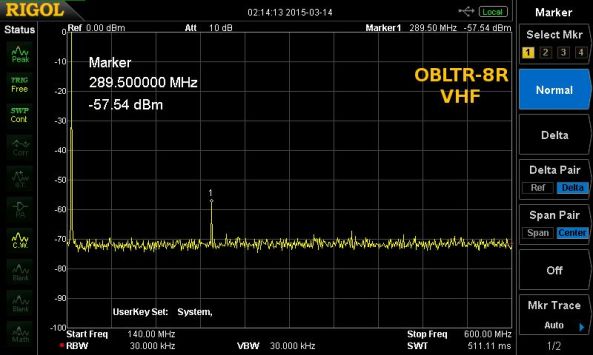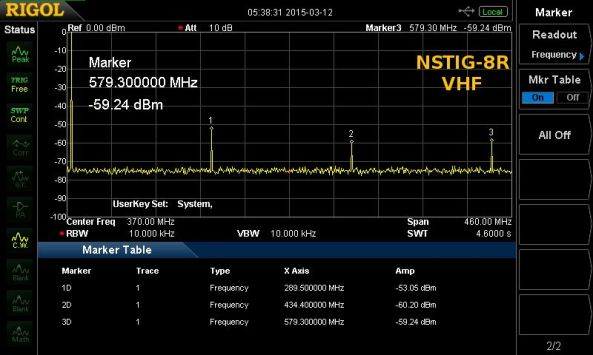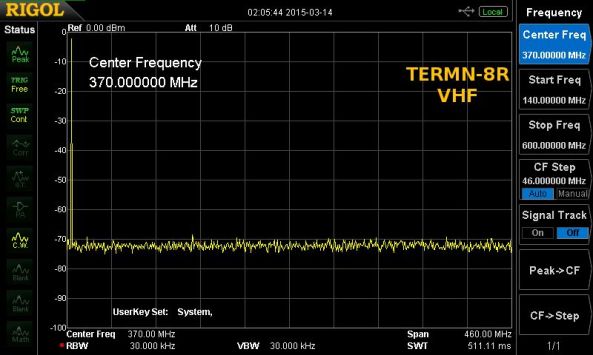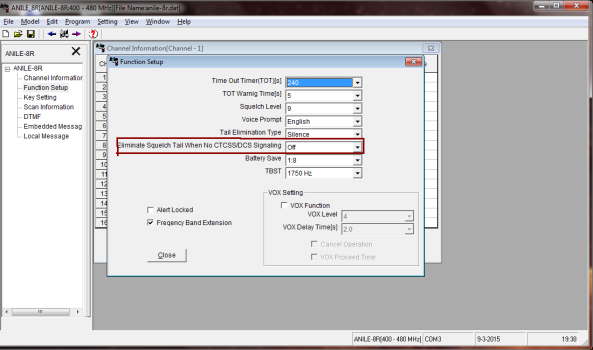Archive for the ‘review’ Category
 Anytone Tech models, additional notes
Anytone Tech models, additional notes
Overall, reviewing these Anytones was a pleasant experience. After the reviews I looked into a few other things.
- The batteries of the ANILE-8R (1300 mAh) and the NSTIG-8R (1800 mAh) are exchangeable.
- The belt clips used on the ANILE-8R and NSTIG-8R are never a perfect fit. With the 1300 mAh battery there’s a gap (easy to lose a radio that way), with the 1800 mAh battery it’s too tight.
- The antenna on the NSTIG-8R heats up fast at maximum RF output; the behavior resembles that of a Baofeng UV-5R stock antenna. The antenna appears to be reasonably efficient though. More tests are in order.
- No such problems with the antennas of the ANILE-8R, the TERMN-8R or OBLTR-8R.
- The NSTIG-8R, TERMN-8R and OBLTR-8R can display the remaining battery voltage. Measurements show that the radios are surprisingly accurate. If the radios say “8.1 Volts”, it really is 8.1 Volts. The ANILE-8R will round it down/up to the closest integer.
- The TERMN-8R is difficult to use on SW because it defaults to 10 KHz steps. SW stations are 5 KHz apart, not 10 KHz. You can use the keypad to enter the correct frequency though. I had the bug confirmed by John; it’s now on the ‘to do’ list and will be fixed.
- The more I had the TX audio compared by other hams, the more impressed I (and they) became.
- There’s an odd problem concerning spectral purity with all x-band capable hand helds I reviewed. It only occurs when both VFOs are active; we (me and a few more knowledgeable RF lab gurus) are looking into that right now.
 Review Anytone OBLTR-8R
Review Anytone OBLTR-8R
by John ‘Miklor’ K3NXU and Hans PD0AC
 I now get a chance to review the OBLTR-8R which is a slightly scaled down version of the TERMN-8R which is the top of the new 8R series offered by Anytone. The only outward difference between the two models is the absence of the orange keys on the left. Once again, when you get one in hand, it becomes very obvious that these radios are were not meant to be competition for the lower end brands, but more of a match for the Wouxun and existing Anytone radios.
I now get a chance to review the OBLTR-8R which is a slightly scaled down version of the TERMN-8R which is the top of the new 8R series offered by Anytone. The only outward difference between the two models is the absence of the orange keys on the left. Once again, when you get one in hand, it becomes very obvious that these radios are were not meant to be competition for the lower end brands, but more of a match for the Wouxun and existing Anytone radios.
This radio is FCC Part 90 certified (Commercial) applications, as well as Part 95A GMRS and 95J MURS services. For GMRS and MURS, the frequencies and power levels hard coded in the firmware. Anyone with dual licenses may now only need to carry a single radio.
What’s in the BOX
There you’ll find the radio, a nicely written and illustrated 104 page English manual, belt clip, wrist strap, Earpiece/Microphone, 7.25 inch (18cm) flexible antenna and hefty 2200mAh 7.4V battery with charger.
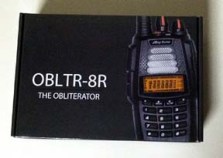
The side of the battery has a small charging jack for the optional 12V mobile charger is available for on the road charging.
First Impressions
The overall weight and feel of the radio is solid. The top of the radio has both a Volume/PowerOn switch and Channel Selector knob. The left side has the PTT button and well as two programmable function buttons. The right side has a 2 pin ‘K2′ Kenwood, Anytone, Wouxun, Baofeng style connector. Programming cables and Spkr/Micr for these radios will be totally compatible.
My prior Anytones have somewhat of a concave keypad, where the OBLTR-8R keypad buttons are level and easier to access. Also, the keypad numbers and definitions are illuminated making manual programming a bit easier.
Transmitter
The OBLTR-8R, like its big brother the TERMN-8R, also has 3 power levels that can be changed from the keypad. In the GMRS and MURS mode, the power levels are fixed, per certification requirements. Audio level and quality reports were excellent.
Receiver
The OBLTR-8R has a single Dual Watch receiver that covers
VHF – 136-174 MHz UHF – 400-520 MHz
FM Broadcast – 64-108 MHz (with 100 memory channels)
It incorporates Fast Scan with a scan rate of approximately 10 channels per second.
Some measurements
Power Levels on the test unit were as follows:
VHF – 5.6W, 1.9W, 0.9W
UHF – 4.75W, 2.3W, 1.2W
GMRS – 4.25W
MURS – 1.8W
Sensitivity
Sensitivity VHF (@ 145 MHz): -126 dBm (@ 50Ω, 12 dB SINAD).
Sensitivity UHF (@ 435 MHz): -125 dBm (@ 50Ω, 12 dB SINAD).
Harmonics
Good numbers: -57.54 dBm on VHF, -54.74 dBm on UHF.
When in the Dual Watch mode, the receiver continuously samples the main and sub-band for activity. To eliminate adjacent channel interference, the radio’s receiver reverts to true Narrowband when selected. A full 1W of audio makes the receive quality both loud and clear.
GMRS and MURS operation (FCC part 95A / 95J certified)
Like its big brother, the OBLTR-8R can be switched to operate on any of three modes. GMRS, MURS or Commercial/Normal. To eliminate the possibility of being on the wrong band, a Key Press at PowerOn selects either GMRS or MURS mode. Channel frequencies are hard coded in the firmware as well as their power levels, but allow for CTCSS/DCS tones can be added/changed via the keypad.
Commercial Application (FCC Part 90 certified)
For Commercial, Fire, EMS and EmComm use, the OBLTR-8R is fully certificated with 2.5kHz steps, and software which prevents Field Programming.
NOAA Weather Alert
The seven US NOAA weather alert frequencies are preprogrammed into the radio. There are 3 options to choose from. ON, OFF and ALERT. When WX Alert is chosen, the NOAA weather channel remains silent in the background until the 1050Hz emergency tone signal is received. This is especially useful in areas where severe weather conditions are prominent.
Dual PTT Capability / Programmable Function Keys
There are two PF keys below the PTT switch. Either can be programmed to function as a sub-channel (lower display) PTT button, while the PTT switch activates the upper channel.
The PF keys can also be used to select your choice of:
– Battery Voltage display
– Frequency display
– Tone Calling (DTMF/5TONE/2TONE)
– FHSS (Frequency Hopping)
– Tone Pulse (1750, 1450, 1000 or 2100Hz)
– Alarm Button
– Dual PTT
– MONI (Squelch off)
Channel Banks
The radio supports 200 channels and 10 memory banks. Scanning Group 0 will scan all programmed channels entered into the transceiver. Banks 1 > 9 can be assigned up to 32 channels each.
I found a nice added feature that isn’t on my 3318UV-A. If I want to remove a channel from a particular bank, I can dial in the channel, press two keys, turn the knob and it’s gone. Eliminates the need to me to use the computer to delete the bad ones.
2TONE Sequential Paging
This is extremely useful for the EMS user. I personally have used 2 tone pagers in the past. I can now monitor local EMS channels with one radio.
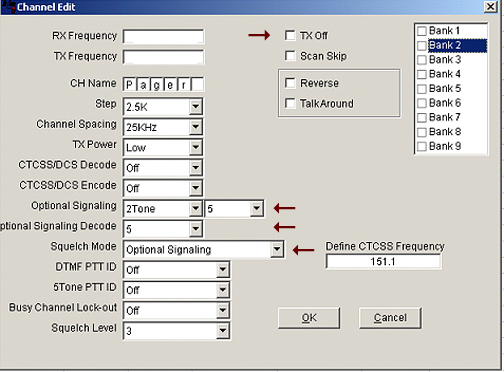 Detailed instructions on how to set up the 2-tone and 5-tone paging system can be found HERE.
Detailed instructions on how to set up the 2-tone and 5-tone paging system can be found HERE.
Software
The OEM software is relatively easy to follow, and with a little practice, easy to navigate. Some areas may be a bit tricky, and I’ll try to address those area in the Miklor FAQ section. CHIRP developers are aware of the new Anytone 8R series, but it takes time to backward engineer a radios software.
As always, it is recommended to get a quality programming cable so you spend more time talking on the radio and less time loading special drivers to your PC. I personally use an FTDI cable that is Plug ‘n Play with no driver issues.
Upgradeable Firmware
The OBLTR-8R has Upgradeable Firmware. If features are added in the future, your radio is not obsolete. The firmware can be updated (re-flashed) by an authorized dealer so you will always be able to have the latest version available to you.
IMHO
The developers of the Anytone OBLTR-8R packed a lot of features in a small package. The inclusion of:
– Certified GMRS, MURS and Commercial in one radio
– Upgradeable Firmware
– 200 channels/10 Banks
– Dual PTT
– 2TONE / 5TONE / MSK Messaging
– Stun / Kill capability
at a price tag under $100 level is pretty darned impressive.
Comparison
There are four models in the 8R series. At the top is the TERMN-8R, followed by the OBLTR-8R, NSTIG-8R, and the ANILE-8R. Confusing? Here’s a hint. They are alphabetical. That’s the only way I can keep them straight.
For a comparison between the OBLTR-8R and the others in the 8R series, you can follow this LINK
Price: $98.89 USD (Amazon)
More Information: Anytone Tech, Miklor.com
 Review Anytone OBLTR-8R
Review Anytone OBLTR-8R
by John ‘Miklor’ K3NXU and Hans PD0AC
 I now get a chance to review the OBLTR-8R which is a slightly scaled down version of the TERMN-8R which is the top of the new 8R series offered by Anytone. The only outward difference between the two models is the absence of the orange keys on the left. Once again, when you get one in hand, it becomes very obvious that these radios are were not meant to be competition for the lower end brands, but more of a match for the Wouxun and existing Anytone radios.
I now get a chance to review the OBLTR-8R which is a slightly scaled down version of the TERMN-8R which is the top of the new 8R series offered by Anytone. The only outward difference between the two models is the absence of the orange keys on the left. Once again, when you get one in hand, it becomes very obvious that these radios are were not meant to be competition for the lower end brands, but more of a match for the Wouxun and existing Anytone radios.
This radio is FCC Part 90 certified (Commercial) applications, as well as Part 95A GMRS and 95J MURS services. For GMRS and MURS, the frequencies and power levels hard coded in the firmware. Anyone with dual licenses may now only need to carry a single radio.
What’s in the BOX
There you’ll find the radio, a nicely written and illustrated 104 page English manual, belt clip, wrist strap, Earpiece/Microphone, 7.25 inch (18cm) flexible antenna and hefty 2200mAh 7.4V battery with charger.

The side of the battery has a small charging jack for the optional 12V mobile charger is available for on the road charging.
First Impressions
The overall weight and feel of the radio is solid. The top of the radio has both a Volume/PowerOn switch and Channel Selector knob. The left side has the PTT button and well as two programmable function buttons. The right side has a 2 pin ‘K2’ Kenwood, Anytone, Wouxun, Baofeng style connector. Programming cables and Spkr/Micr for these radios will be totally compatible.
My prior Anytones have somewhat of a concave keypad, where the OBLTR-8R keypad buttons are level and easier to access. Also, the keypad numbers and definitions are illuminated making manual programming a bit easier.
Transmitter
The OBLTR-8R, like its big brother the TERMN-8R, also has 3 power levels that can be changed from the keypad. In the GMRS and MURS mode, the power levels are fixed, per certification requirements. Audio level and quality reports were excellent.
Receiver
The OBLTR-8R has a single Dual Watch receiver that covers
VHF – 136-174 MHz UHF – 400-520 MHz
FM Broadcast – 64-108 MHz (with 100 memory channels)
It incorporates Fast Scan with a scan rate of approximately 10 channels per second.
Some measurements
Power Levels on the test unit were as follows:
VHF – 5.6W, 1.9W, 0.9W
UHF – 4.75W, 2.3W, 1.2W
GMRS – 4.25W
MURS – 1.8W
Sensitivity
Sensitivity VHF (@ 145 MHz): -126 dBm (@ 50Ω, 12 dB SINAD).
Sensitivity UHF (@ 435 MHz): -125 dBm (@ 50Ω, 12 dB SINAD).
Harmonics
Good numbers: -57.54 dBm on VHF, -54.74 dBm on UHF.
When in the Dual Watch mode, the receiver continuously samples the main and sub-band for activity. To eliminate adjacent channel interference, the radio’s receiver reverts to true Narrowband when selected. A full 1W of audio makes the receive quality both loud and clear.
GMRS and MURS operation (FCC part 95A / 95J certified)
Like its big brother, the OBLTR-8R can be switched to operate on any of three modes. GMRS, MURS or Commercial/Normal. To eliminate the possibility of being on the wrong band, a Key Press at PowerOn selects either GMRS or MURS mode. Channel frequencies are hard coded in the firmware as well as their power levels, but allow for CTCSS/DCS tones can be added/changed via the keypad.
Commercial Application (FCC Part 90 certified)
For Commercial, Fire, EMS and EmComm use, the OBLTR-8R is fully certificated with 2.5kHz steps, and software which prevents Field Programming.
NOAA Weather Alert
The seven US NOAA weather alert frequencies are preprogrammed into the radio. There are 3 options to choose from. ON, OFF and ALERT. When WX Alert is chosen, the NOAA weather channel remains silent in the background until the 1050Hz emergency tone signal is received. This is especially useful in areas where severe weather conditions are prominent.
Dual PTT Capability / Programmable Function Keys
There are two PF keys below the PTT switch. Either can be programmed to function as a sub-channel (lower display) PTT button, while the PTT switch activates the upper channel.
The PF keys can also be used to select your choice of:
– Battery Voltage display
– Frequency display
– Tone Calling (DTMF/5TONE/2TONE)
– FHSS (Frequency Hopping)
– Tone Pulse (1750, 1450, 1000 or 2100Hz)
– Alarm Button
– Dual PTT
– MONI (Squelch off)
Channel Banks
The radio supports 200 channels and 10 memory banks. Scanning Group 0 will scan all programmed channels entered into the transceiver. Banks 1 > 9 can be assigned up to 32 channels each.
I found a nice added feature that isn’t on my 3318UV-A. If I want to remove a channel from a particular bank, I can dial in the channel, press two keys, turn the knob and it’s gone. Eliminates the need to me to use the computer to delete the bad ones.
2TONE Sequential Paging
This is extremely useful for the EMS user. I personally have used 2 tone pagers in the past. I can now monitor local EMS channels with one radio.
 Detailed instructions on how to set up the 2-tone and 5-tone paging system can be found HERE.
Detailed instructions on how to set up the 2-tone and 5-tone paging system can be found HERE.
Software
The OEM software is relatively easy to follow, and with a little practice, easy to navigate. Some areas may be a bit tricky, and I’ll try to address those area in the Miklor FAQ section. CHIRP developers are aware of the new Anytone 8R series, but it takes time to backward engineer a radios software.
As always, it is recommended to get a quality programming cable so you spend more time talking on the radio and less time loading special drivers to your PC. I personally use an FTDI cable that is Plug ‘n Play with no driver issues.
Upgradeable Firmware
The OBLTR-8R has Upgradeable Firmware. If features are added in the future, your radio is not obsolete. The firmware can be updated (re-flashed) by an authorized dealer so you will always be able to have the latest version available to you.
IMHO
The developers of the Anytone OBLTR-8R packed a lot of features in a small package. The inclusion of:
– Certified GMRS, MURS and Commercial in one radio
– Upgradeable Firmware
– 200 channels/10 Banks
– Dual PTT
– 2TONE / 5TONE / MSK Messaging
– Stun / Kill capability
at a price tag under $100 level is pretty darned impressive.
Comparison
There are four models in the 8R series. At the top is the TERMN-8R, followed by the OBLTR-8R, NSTIG-8R, and the ANILE-8R. Confusing? Here’s a hint. They are alphabetical. That’s the only way I can keep them straight.
For a comparison between the OBLTR-8R and the others in the 8R series, you can follow this LINK
Price: $98.89 USD (Amazon)
More Information: Anytone Tech, Miklor.com
 Review Anytone NSTIG-8R
Review Anytone NSTIG-8R
 The NSTIG-8R was the first radio I tried out, mainly because it came with a fully charged battery. I punched in some frequencies and took off on a 5-mile walk. The radio performed quite well.
The NSTIG-8R was the first radio I tried out, mainly because it came with a fully charged battery. I punched in some frequencies and took off on a 5-mile walk. The radio performed quite well.
In the box:
- Radio
- 1800 mAh battery
- Antenna (SMA female)
- Simple headset
- Charger
- AC adapter (110-240 Volts)
- Belt clip
- Wrist strap
- Manual
Factory specifications
Frequency range: [TX/RX] 136 – 174MHz, 400 – 520MHz
RX only: 68-108MHz (FM Broadcast)
Channel Capacity: 200 Channels
Channel Spacing: 25KHz (wide band)12.5KHz (narrow band)
Sensitivity: ≤0.25μV (wide band) ≤0.35μV (narrow band)
Operation Voltage: 7.4V DC ±20%
Battery: 1800mAh
Frequency steps (KHz): 2.5, 5, 6.25, 10, 12.5, 20, 25, 30 and 50
Antenna: SMA-Female
Accessory Connector: Kenwood 2-Pin standard
Stability: ±2.5 ppm
Output power: 5W / 1W
Size: 113×62×40mm (with battery)
Weight: 220g (with battery, antenna, belt clip)
Audio Power Output: 1000mW
Build quality
The first thing I noticed is the weight of the NSTIG-8R. While the dimensions of the radio are nearly identical to those of a UV-5R, this radio is quite a bit heavier: 129 grams vs 91 grams (without battery and antenna). With all the bells & whistles attached the scale shows 240 grams vs 209 grams. All in all the radio has a solid feel to it.
Side keys
The NSTIG-8R has three side keys also, and these can be programmed by the user. At default the upper key will switch on the flashlight, the middle one will show you the remaining battery voltage, and the last one will bypass the squelch (monitor).
Dual PTT
If you like you can reprogram one of the side keys to function as PTT for VFO B. The main PTT key is reserved for VFO A and can’t be re-assigned.
Display
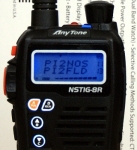 At default the three-color display (amber, blue or purple) shows two frequencies at the same time and will be in dual watch mode. There’s no ‘TDR’ option in the menu; if you want to switch off dual watch you press Function+Main to toggle between dual watch and single band mode.
At default the three-color display (amber, blue or purple) shows two frequencies at the same time and will be in dual watch mode. There’s no ‘TDR’ option in the menu; if you want to switch off dual watch you press Function+Main to toggle between dual watch and single band mode.
In single band mode you can switch between VFO A en B by just pressing the Main key. The system takes a little bit time to get used to.
 Nice touch: even when attached to your belt you can see which VFO is active. When the RX LED turns green the upper VFO is active, when turning blue the lower VFO is active. Contrary to a Baofeng you can select VFO mode or memory mode for each individual VFO.
Nice touch: even when attached to your belt you can see which VFO is active. When the RX LED turns green the upper VFO is active, when turning blue the lower VFO is active. Contrary to a Baofeng you can select VFO mode or memory mode for each individual VFO.
The S-meter is one that actually works. Meters on hand helds are never accurate enough to give a meaningful signal report, but at least you get a basic idea of the field strength.
Programming
Most of the programming can be done from the keypad, including alpha tags. The software is necessary to change the welcome message, or give the radio its own ID and pre-programmed DTMF sequences — something you will need if you decide to use individual or group calling. You can do a lot manually, which will come in handy in the field, but using the software will work faster and give you access to a lot of other options.
I think it’s really a shame that there’s no Help section in the software. With basic channel-editing software I couldn’t care less, but this program offers quite a few exotic options. I guess that figuring it all out will be left to us, after which we can document it on Miklor.com.
Memories
You can program 200 VHF/UHF frequencies and 99 FM broadcast frequencies. I won’t be able to fill that up easily, but I’m sure there will be others who won’t have any problems filling these up to the max.
Scanning
Most Chinese radios are poor, painfully slow scanners. For the first time in years I can report that scan speed is actually acceptable: about 4-5 channels/second. Not brilliant, but usable. The top models in the 8R series have a Fast Scan mode which clocks at 10 channels/second.
The NSTIG-8R can scan for CTCSS/DCS codes, and you can set VFO scanning limits.
Bugs
Haven’t been able to find one.
Various measurements
TX audio: loud and clear, just like the ANILE-8R. No complaints.
RX audio: Same story: loud and clear, with no noticeable distortion.
Sensitivity VHF (@ 145 MHz): -127 dBm (@ 50Ω, 12 dB SINAD).
Sensitivity UHF (@ 435 MHz): -125 dBm (@ 50Ω, 12 dB SINAD).
Frequency accuracy of this sample: VHF: 0 Hz, UHF -13 Hz.
Power output VHF (@145 MHz): 1.3 Watts / 4.9 Watts.
Power output UHF (@435 MHz): 1.1 Watts / 4.3 Watts.
Front-end: good, but not as good as the Wouxun KG-UV6D or QuanSheng TG-UV2.
Harmonic suppression: three measurable harmonics on VHF, varying between -53.05 dBm and -60.20 dBm, on UHF there’s only one at -57.33 dBm.
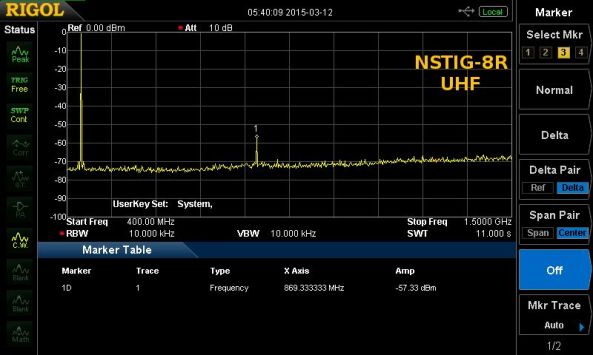 Conclusion
Conclusion
I really like the NSTIG-8R. The design is refreshing, the radio offers more functionality than the average low cost radio, and it’s built like a tank.
The price of the radio is twice that of a Baofeng and half that of a basic(*) Yaesu FT-60. I understand people muttering about prices (it’s the first thing we hams do, it must be in our DNA), but the relation between price and quality is right on target here.
There’s always a choice: you go for the cheapest, for the best, or for something in between. Seen from that perspective the NSTIG-8R nicely fills the gap between Baofengs and Yaesu’s entry level radio.
(*) The Yaesu FT-60 does not come with a desktop charger, 1800 mAh battery or headset – you need to add about $120 for these accessories)
Price: $68.89 (Amazon)
More information: Anytone Tech
 Review Anytone TERMN-8R
Review Anytone TERMN-8R
by John K3NXU
The Buzz 
The recent entry of the Anytone 8R series has raised some eyebrows lately. Here, we are going to take a look at the TERMN-8R (aka terminator). First, this is definitely not a rebranding of an old design, but a fresh set of features not usually found in one model.
Features such as a Bi-Directional Cross Band Repeat function, Pre-programmed Weather Channels with Alert Tone, and 2TONE and 5TONE squelch and Paging for the EMS and Fire services, and the Part 90, 95A, 95J certifications for Commercial, GMRS and MURS in the US.
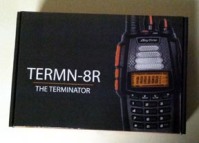
What’s in the BOX
A nicely written and illustrated 104 page English manual, belt clip, lanyard, Earpiece/Microphone, 7.25 inch (18cm) flexible antenna and hefty 2200mAh 7.4V battery with charger.
I noticed the side of the 2200mAh had a small charging jack. When I checked the AnytoneTech accessories page, I found that a 12V mobile charger is available for on the road charging.
First Impression
After inserting the battery, you immediately notice the overall weight and feel of the radio. It has a solid feel and fits my large hand nicely.
The top of the radio has the traditional Volume/PowerOn switch and Channel Selector. The left side has the PTT switch and well as two programmable function switches. The right has a 2 pin ‘K2′ Kenwood, Anytone, Wouxun, Baofeng style connector, meaning most available accessories will be totally compatible.
My prior Anytones have somewhat of a concave keypad. I found the button access much easier. The keypad numbers and definitions both light up making manual programming a bit easier.
Transmitter
The TERMN-8R transmitter has 3 power levels. For Normal operation, the power levels can be changed from the keypad. In the GMRS and MURS mode, the power levels are fixed. My Over the Air contacts have received excellent quality and level reports.
Power Levels clock in as follows:
VHF – 5.6W, 2.4W, 1.2W
UHF – 4.5W, 2.25W, 1.25W
GMRS – 4.15W
MURS – 1.95W
Dual Receivers
The TERMN-8R has Dual Receivers that function over six bands: VHF, UHF, Aviation Band (108-136MHz), Shortwave (AM 2.3 – 30MHz), AM Broadcast (520-1710kHz) and FM Broadcast (64-108MHz). Both the FM Broadcast Band and expanded Aviation Band include 100 memory channels each and can be used with Fast Scan (see below)
Dual Receivers allow for receiving two signals simultaneously, rather than just sampling for activity. This is important if the sub-channel is set for Weather Alerts (1050Hz) or EMS / EmComm Services Alerts or Paging. It also provides for bi-directional Cross Band repeating.
To eliminate side channel interference, the radio’s receiver reverts to true Narrow band when selected.
GMRS and MURS operation (FCC part 95A / 95J certified)
This TERMN-8R can be switched to operate on any of three modes. GMRS, MURS or Commercial/Normal. To eliminate the possibility of being on the wrong band, a Key Press at PowerOn selects either GMRS or MURS mode. The channel frequencies are hard coded in the firmware as well as their power levels, but allow for CTCSS/DCS tones can be added/changed via the keypad.
Commercial Application (FCC Part 90 certified)
For Commercial, Fire, EMS and EmComm use, the TERMN-8R is fully certificated with 2.5kHz steps, and software which prevents Field Programming.
Cross-Band Repeater
This function allows retransmitting a VHF signal to UHF (or UHF to VHF). To test, I set the main channel to a local VHF repeater, and the sub-channel to a UHF simplex channel, then activated the Repeat function. Audio reports both to and from the repeater were excellent.
In this mode, both receivers are active simultaneously. The first active receive signal takes repeat priority. When that signal drops, both receivers return to active standby.
Aviation Band
I had a chance to play with the Air Band receiver that covers the entire 108 to 136MHz. Up to 100 channels can be stored and either individually selected or scanned. I entered 10 of the most used frequencies in the area, then activated the scan mode. When a signal is found, the receiver paused for 5 seconds, then returned to the scan mode. The scanning process can easily be stopped by pressing one key.
Another nice feature is Fast Scan. This increases the radios scanning rate to 10 channels per second. Three time faster than my Baofengs. Especially nice when scanning stored Air Band frequencies.
Even if your not close to an airport, keep in mind that an aircraft running 10W and flying at 20,000 ft has a range of approximately 170 miles.
Shortwave Bands (AM)
For those enjoying the Shortwave bands, there is AM coverage from 2.3 to 30MHz. You can enter a frequency directly, then enter the scan mode if desired. Even with the supplied antenna, I was quite pleased with what was received. Attaching the radio to a full size outside antenna connects the SWL to the rest of the world.
NOAA Weather Alert
The seven US NOAA weather alert frequencies are preprogrammed into the radio. There are 3 options to choose from. ON, OFF and ALERT. When WX Alert is chosen, the NOAA weather channel remains silent in the background until the 1050Hz emergency tone signal is received. This is especially useful in areas where severe weather conditions are prominent.
Dual PTT Capability / Programmable Function Keys
There are two PF keys below the PTT switch. Either can be programmed to function as a sub-channel (lower display) PTT button, while the PTT switch activates the upper channel.
The PF keys can also be used to select your choice of:
– Battery Voltage display
– Frequency display
– Tone Calling (DTMF/5TONE/2TONE/MSK)
– FHSS (Frequency Hopping)
– Tone Pulse (1750, 1450, 1000 or 2100Hz)
– Alarm Button
– Dual PTT
– MONI (Squelch off)
Channel Banks
The radio supports 200 channels and 10 memory banks. Group 0 contains all channels entered into the transceiver. Banks 1 > 9 can be assigned up to 32 channels each.
I found a nice added feature that isn’t on my 3318UV-A. If I want to remove a channel from a particular bank, I can dial in the channel, press two keys, turn the knob and it’s gone. Eliminates the need to me to use the computer to delete the bad ones.
2-TONE Sequential Paging
This is extremely useful for the EMS user. I personally have used 2-tone pagers in the past (Motorola and Plectron). It’s nice to know that I can now monitor local EMS channels with one radio. The advantage of the TERMN-8R’s dual receiver is the pager tone will come through, even if the other receiver is active.
 Detailed instructions on how to set up the 2-tone and 5-tone paging system can be found here.
Detailed instructions on how to set up the 2-tone and 5-tone paging system can be found here.
Software
The OEM software is relatively easy to follow, and with a little practice, easy to navigate. Some areas may be a bit tricky, and I’ll try to address those area in the Miklor FAQ section. CHIRP developers are aware of the new Anytone 8R series, but it takes time to reverse engineer the software.
As always, it is recommended to get a quality programming cable so you spend more time talking on the radio and less time loading special drivers to your PC. I personally use an FTDI cable that is Plug ‘n Play with no driver issues.
Upgradeable Firmware
The TERMN-8R has Upgradeable Firmware. If features are added in the future, your radio is not becoming obsolete. The firmware can be updated by an authorized dealer so you will always be able to have the latest version available to you.
IMHO
I think the developers of the Anytone TERMN-8R outdid themselves on this one. The inclusion of the:
– Certified GMRS, MURS and Commercial in one radio
– Cross Band Repeater
– Two internal receivers
– Upgradeable Firmware
– 6 Band capability
– 200 channels/10 Banks
– Dual PTT
– 2TONE / 5TONE / MSK Messaging
– Stun / Kill capability
makes this one of the most versatile radios on the market.
Comparison
For a feature comparison between this model and the others in the 8R series, you can follow this LINK.
Price: $138.89 (Amazon)
More Information: Anytone Tech, Miklor.com
 Review Anytone TERMN-8R
Review Anytone TERMN-8R
by John K3NXU and Hans PD0AC
The Buzz 
The recent entry of the Anytone 8R series has raised some eyebrows lately. Here, we are going to take a look at the TERMN-8R (aka terminator). First, this is definitely not a rebranding of an old design, but a fresh set of features not usually found in one model.
Features such as a Bi-Directional Cross Band Repeat function, Pre-programmed Weather Channels with Alert Tone, and 2TONE and 5TONE squelch and Paging for the EMS and Fire services, and the Part 90, 95A, 95J certifications for Commercial, GMRS and MURS in the US.

What’s in the BOX
Besides the radio, there’s a nicely written and illustrated 104 page English manual, belt clip, wrist strap, Earpiece/Microphone, 7.25 inch (18cm) flexible antenna and hefty 2200mAh 7.4V battery with charger.
I noticed the side of the 2200mAh had a small charging jack. When I checked the AnytoneTech accessories page, I found that a 12V mobile charger is available for on the road charging.
First Impression
After inserting the battery, you immediately notice the overall weight and feel of the radio. It has a solid feel and fits my large hand nicely.
The top of the radio has the traditional Volume/PowerOn switch and Channel Selector. The left side has the PTT button and well as two programmable function buttons. The right has a 2 pin ‘K2’ Kenwood, Anytone, Wouxun, Baofeng style connector, meaning most available accessories will be totally compatible.
My prior Anytones have somewhat of a concave keypad. I found the button access much easier. The keypad numbers and definitions both light up making manual programming a bit easier.
Transmitter
The TERMN-8R transmitter has 3 power levels. For Normal operation, the power levels can be changed from the keypad. In the GMRS and MURS mode, the power levels are fixed. My Over the Air contacts have received excellent quality and level reports.
Some measurements
Power Levels on the test unit were as follows:
VHF – 5.6W, 2.4W, 1.2W
UHF – 4.5W, 2.25W, 1.25W
GMRS – 4.15W
MURS – 1.95W
Sensitivity
Sensitivity VHF (@ 145 MHz): -126 dBm (@ 50Ω, 12 dB SINAD).
Sensitivity UHF (@ 435 MHz): -125 dBm (@ 50Ω, 12 dB SINAD).
Harmonics
Excellent numbers — nothing to see on VHF, -57.83 dBm on UHF.
Dual Receivers
The TERMN-8R has Dual Receivers that function over six bands: VHF, UHF, Aviation Band (108-136MHz), Shortwave (AM 2.3 – 30MHz), AM Broadcast (520-1710kHz) and FM Broadcast (64-108MHz). Both the FM Broadcast Band and expanded Aviation Band include 100 memory channels each and can be used with Fast Scan (see below)
Dual Receivers allow for receiving two signals simultaneously, rather than just sampling for activity. This is important if the sub-channel is set for Weather Alerts (1050Hz) or EMS / EmComm Services Alerts or Paging. It also provides for bi-directional Cross Band repeating.
To eliminate side channel interference, the radio’s receiver reverts to true Narrow band when selected.
GMRS and MURS operation (FCC part 95A / 95J certified)
This TERMN-8R can be switched to operate on any of three modes. GMRS, MURS or Commercial/Normal. To eliminate the possibility of being on the wrong band, a Key Press at PowerOn selects either GMRS or MURS mode. The channel frequencies are hard coded in the firmware as well as their power levels, but allow for CTCSS/DCS tones can be added/changed via the keypad.
Commercial Application (FCC Part 90 certified)
For Commercial, Fire, EMS and EmComm use, the TERMN-8R is fully certificated with 2.5kHz steps, and software which prevents Field Programming.
Cross-Band Repeater
This function allows retransmitting a VHF signal to UHF (or UHF to VHF). To test, I set the main channel to a local VHF repeater, and the sub-channel to a UHF simplex channel, then activated the Repeat function. Audio reports both to and from the repeater were excellent.
In this mode, both receivers are active simultaneously. The first active receive signal takes repeat priority. When that signal drops, both receivers return to active standby.
Aviation Band
I had a chance to play with the Air Band receiver that covers the entire 108 to 136MHz. Up to 100 channels can be stored and either individually selected or scanned. I entered 10 of the most used frequencies in the area, then activated the scan mode. When a signal is found, the receiver paused for 5 seconds, then returned to the scan mode. The scanning process can easily be stopped by pressing one key.
Another nice feature is Fast Scan. This increases the radios scanning rate to 10 channels per second. Three time faster than my Baofengs. Especially nice when scanning stored Air Band frequencies.
Even if your not close to an airport, keep in mind that an aircraft running 10W and flying at 20,000 ft has a range of approximately 170 miles.
Shortwave Bands (AM)
For those enjoying the Shortwave bands, there is AM coverage from 2.3 to 30MHz. You can enter a frequency directly, then enter the scan mode if desired. Even with the supplied antenna, I was quite pleased with what was received. Attaching the radio to a full size outside antenna connects the SWL to the rest of the world.
NOAA Weather Alert
The seven US NOAA weather alert frequencies are preprogrammed into the radio. There are 3 options to choose from. ON, OFF and ALERT. When WX Alert is chosen, the NOAA weather channel remains silent in the background until the 1050Hz emergency tone signal is received. This is especially useful in areas where severe weather conditions are prominent.
Dual PTT Capability / Programmable Function Keys
There are two PF keys below the PTT switch. Either can be programmed to function as a sub-channel (lower display) PTT button, while the PTT switch activates the upper channel.
The PF keys can also be used to select your choice of:
– Battery Voltage display
– Frequency display
– Tone Calling (DTMF/5TONE/2TONE/MSK)
– FHSS (Frequency Hopping)
– Tone Pulse (1750, 1450, 1000 or 2100Hz)
– Alarm Button
– Dual PTT
– MONI (Squelch off)
Channel Banks
The radio supports 200 channels and 10 memory banks. Group 0 contains all channels entered into the transceiver. Banks 1 > 9 can be assigned up to 32 channels each.
I found a nice added feature that isn’t on my 3318UV-A. If I want to remove a channel from a particular bank, I can dial in the channel, press two keys, turn the knob and it’s gone. Eliminates the need to me to use the computer to delete the bad ones.
2-TONE Sequential Paging
This is extremely useful for the EMS user. I personally have used 2-tone pagers in the past (Motorola and Plectron). It’s nice to know that I can now monitor local EMS channels with one radio. The advantage of the TERMN-8R’s dual receiver is the pager tone will come through, even if the other receiver is active.
 Detailed instructions on how to set up the 2-tone and 5-tone paging system can be found here.
Detailed instructions on how to set up the 2-tone and 5-tone paging system can be found here.
Software
The OEM software is relatively easy to follow, and with a little practice, easy to navigate. Some areas may be a bit tricky, and I’ll try to address those area in the Miklor FAQ section. CHIRP developers are aware of the new Anytone 8R series, but it takes time to reverse engineer the software.
As always, it is recommended to get a quality programming cable so you spend more time talking on the radio and less time loading special drivers to your PC. I personally use an FTDI cable that is Plug ‘n Play with no driver issues.
Upgradeable Firmware
The TERMN-8R has Upgradeable Firmware. If features are added in the future, your radio is not becoming obsolete. The firmware can be updated (re-flashed) by an authorized dealer so you will always be able to have the latest version available to you.
IMHO
I think the developers of the Anytone TERMN-8R outdid themselves on this one. The inclusion of the:
– Certified GMRS, MURS and Commercial in one radio
– Cross Band Repeater
– Two internal receivers
– Upgradeable Firmware
– 6 Band capability
– 200 channels/10 Banks
– Dual PTT
– 2TONE / 5TONE / MSK Messaging
– Stun / Kill capability
makes this one of the most versatile radios on the market.
Comparison
For a feature comparison between this model and the others in the 8R series, you can follow this LINK.
Price: $138.89 USD (Amazon)
More Information: Anytone Tech, Miklor.com
 Review Anytone ANILE-8R
Review Anytone ANILE-8R
 The ANILE-8R was not the first Anytone Tech model I unpacked, but it will be the first to be reviewed thanks to its simplicity.
The ANILE-8R was not the first Anytone Tech model I unpacked, but it will be the first to be reviewed thanks to its simplicity.
Baofeng vs Anytone
In terms of design this radio resembles the Baofeng BF-666S/BF-777S/BF-888S series: 16 channels, no thrills no frills, no display – just on/off/volume, a flashlight and a 16-channel selector. Both radios tell you which channel is active by using a speech processor. Based on this the two radios could be regarded as competitors.
I kept my Baofeng BF-666S in spite of its generous amount of flaws: the receiver can be trashed by about any out-of-band signal or mixer product, the oscillator isn’t stable (phase noise, which causes reciprocal mixing), and RX audio sounds raw, unfinished even. TX audio however is fine, battery life is great, and the price (below $20) is hard to beat.
The consequence of Baofeng’s cheap design is that I only can use the radio when I’m far enough away from any RF pollution. As you can imagine I was very curious if the ANILE-8R would outperform the Baofeng or not.
In the box
The radio, antenna, 7.4 Volts 1300 mAh battery, charger, power adapter, headset, small strap, manual.
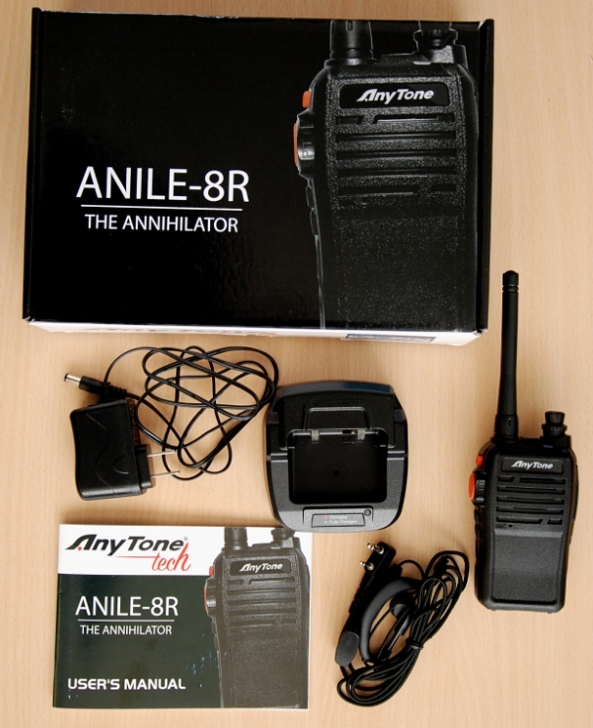 Build quality
Build quality
These radios are ideal for outdoor activities, because there’s not much you can break. The Baofeng already did well, but the Anytone feels much sturdier. It’s well built.
Side keys
There are three side keys and you can program them yourself. At default the upper key will switch on the flashlight, the middle one will tell you the remaining battery voltage, and the last one will bypass the squelch (monitor).
Programming options
Scanning, priority channel selection, CTCSS, DCS, and DTMF calling methods (individual or group calls).
Phase noise
The first thing I looked at was phase noise. During instruction evenings I use the Baofeng as the prime example of poor design; all I could hope for was that Anytone did a better job. They did.
The first image shows the Baofeng (notice the wide ‘shoulders’ which shouldn’t be there), the second image is the Anytone. I slightly zoomed in on the Anytone carrier to get a better view.
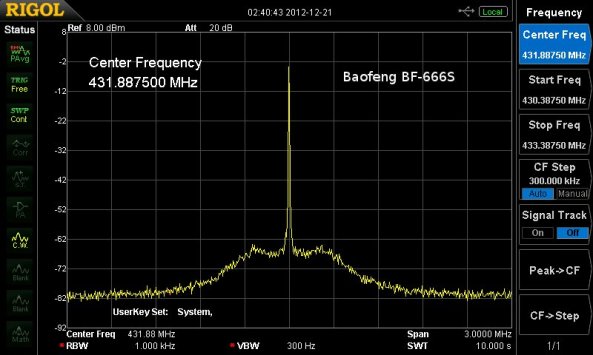
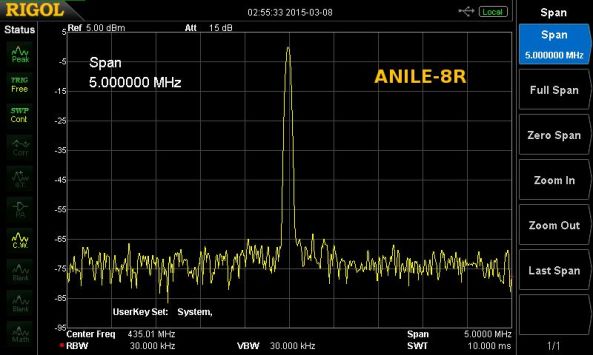
Harmonics
The Baofeng has no detectable harmonics, the ANILE-8R has one at -57.62 dBm. It’s just short of the -60 dBm I like to see, but nothing to worry about.
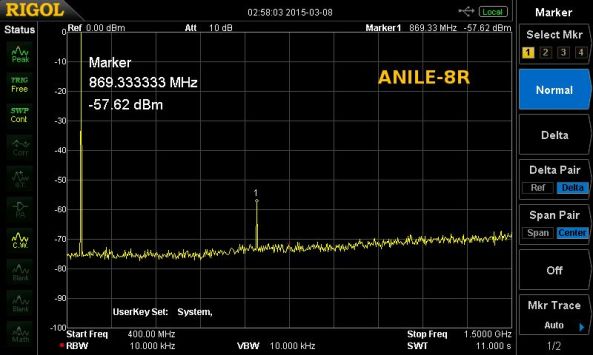
TX audio: loud and clear, just excellent. The most memorable quote from a listener was “I can’t tell the difference between this one and your gear at home.”
RX audio: Same story: loud and clear, with no noticeable distortion.
Sensitivity (@ 435 MHz): -125 dBm (@ 50Ω, 12 dB SINAD).
Frequency accuracy of this sample: -26 Hz.
Power output (@435 MHz): 1.2 Watts / 4.2 Watts.
Front-end: good. Unlike the Baofeng, the receiver doesn’t collapse quickly.
Bugs:
I noticed that RX audio muted when I switched on the flashlight. Audio stayed muted while a signal was present. Audio came back after:
- the carrier dropped and returned
- pressing PTT or one of the side keys.
Toggling the flashlight on/off had no influence.
I forwarded the bug to John K3NXU (Miklor) and the owner of Anytone Tech. It didn’t take long before my findings were confirmed. However, a few days later I found an option in the software which caught my eye: “Eliminate Squelch Tail When No CTCSS/DCS Signaling”. The default value was 55.2 Hz. When set to ‘Off’, the strange influence of the flashlight on reception is gone. Problem solved.
Conclusion:
Anytone Tech’s ANILE-8R is a very good radio and can make you forget the Baofeng BF series. Only when I start nitpicking I could make a remark about the belt clip. It didn’t seem to be designed for this radio, as there was quite a gap between the clip and the battery. I solved the problem by bending it a little bit.
Price: $46.99 (Amazon)
More information: Anytone Tech.
